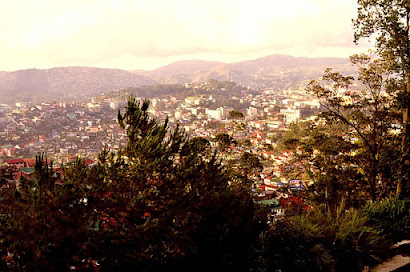 |
| It went the full circle from a monastery, to a war garrison, to a five-star hotel before finally falling into total dereliction and ruin. Today it's just another curious tourist attraction wrapped in a total historical enigma--uncelebrated, unappreciated, its rich heritage story mostly untold. |
Once or twice a year, the young priests attending this seminary school were let out to interact with the local community--doing mostly cathechismal work. They were notable for their excellent men's choir. But for the most part, they kept to themselves and cloistered behind the tall wrought-iron gate that guarded this sprawling 5-hectare estate. It fell into disrepair in the late 70s, a victim of the economic depression and diminishing interest in the catholic priesthood. It was sold for an unknown sum to a local millionaire and faith healer Tony Agpaoa. He refurbished the 50-room mansion into an inn and called it the Diplomat Hotel. It slowly foundered into dereliction and by the end of 1981 accumulating taxes on the property remained unpaid.
Finally, the Government escheated the estate in 1985. It has sat as a veritable white elephant ever since, too expensive for any practical buyer. Looters soon cannibalized the building, reducing it into little more than a crumbling shell of its once glorious self. The huge cross at the top of the building is still visible for kilometers around. In happy Christmases past, it used to hold the largest yuletide display of lights and lanterns. A giant "Star of Bethlehem" measuring almost 25 feet across mounted by seminarians in 1978 still holds the local record for the biggest Christmas lantern ever made in the city, unchallenged to this day.A prayer garden nearby featured the statue of the black Saint Martin de Porres. Several rows of stone pews were once a favorite site for outdoor sacraments, even an occasional garden wedding. Today, the site has been declared a "Heritage Site" by the city government. It’s all just words. In reality, the whole place lies in total ruin. Everytime I come to this place today, my eyes tear up with a profound sadness at how such an iconic place that was so much a part of Baguio City’s history has now become a deathly and mute testimony to the ultimate fate that awaits all men and their institutions---from the height of beauty and splendor to the oblivion of death and destruction. Indeed, death and decay comes to everything and everyone.
 |
| The eerie interior of the Dominican Hill monastery rings faintly of its once glorious past. Not it's just slowly crumbling to dust/ |
NOTE FROM JOEL: Hi, folks! Recently, I started a YouTube channel which is called "Parables and Reason" It is kind of similar to this blog content-wise. You can check out my channel by clicking the link below:
Joel R. Dizon - PARABLES AND REASON













